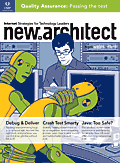Microsoft courts VB faithful: Java competition pressure mounts as XML determines .Net's future

By Tom Sullivan, InfoWorld, July 26, 2002 1:01 pm PT
CENTRAL TO MICROSOFT'S grand vision of unifying its entire software stack through use of XML is the task of keeping its loyal following of VB (Visual Basic) developers in the fold. "Our developers are an important asset, if not the most important asset. Developers drive everything. They're the ones who are going to take us into tomorrow," said Chris Flores, Visual Studio .Net product manager at Redmond, Wash.-based Microsoft...
But as Microsoft asks its developers to leap from VB 6 to VB .Net, a growing band of competitors, including BEA Systems, Sun Microsystems, IBM, and Macromedia, are attempting to increase the size of their own developer communities. The learning curve associated with VB .Net is creating an opportunity for competing vendors. "Microsoft has cause to worry that VB developers will think about moving to Java," said Jason Bloomberg, a consulting analyst at ZapThink Research, a Waltham, Mass.-based market research company that specializes in XML and Web services.
Microsoft, in turn, is fighting back, working to protect its legion of developers by "doing what we always do," Microsoft's Flores said. On the surface level, the software giant's plan has included upgrade tools and an increased concentration on training its corps of developers through seminars and conferences and via its MSDN (Microsoft Developers Network) Web site, which provides lessons and sample code. Microsoft is also making its toolbox work more cohesively with the rest of its products by planting the .Net Framework in all of its servers over time...
According to a survey by Evans Data, more than half of all developers plan to use Java during some part of the time they spend programming this year and next year, whereas only 3 percent will use it exclusively. Use of VB, on the other hand, is expected to decline slightly, with 43.5 percent of respondents planning to use VB next year, down from 46 percent this year.









